On Monday, January 25, the new White House administration announced that all of their regular press briefings will now include an American Sign Language (ASL) interpreter. This is a major announcement, considering President Trump and the White House have neglected to provide adequate accessibility to the deaf and hard of hearing community for the last four years.
According to White House press secretary Jen Psaki, “As a part of this administration’s accessibility and inclusion efforts, starting today, we will have an ASL, an American Sign Language interpreter, for our daily press briefings.” She also included, “The president is committed to building an America that is more inclusive, more just and more accessible for every American, including Americans with disabilities and their families.”
Today, the White House announced that it will have American Sign Language (ASL) interpreters at all daily press briefings. In September 2020, @NAD1880 with @arnoldporter won a court order that set the stage for this… pic.twitter.com/4DlY4jJCCr
— nad1880 (@NAD1880) January 25, 2021
The National Association of the Deaf (NAD), which is “the nation’s premier civil rights organization of, by and for deaf and hard of hearing individuals,” filed a lawsuit back in August to require the White House to immediately enlist ASL interpreters for their coronavirus briefings. Even during a pandemic where briefings are meant to inform the public and provide critical information, the community did not have proper accessibility. This inaccessibility compounds additional barriers, including increased social isolation and difficulty lip-reading and understanding muffled speech behind face masks.
NAD won the lawsuit, noting a historical win for the community. The federal district court ordered the White House to include an interpreter at coronavirus briefings, and the first interpreter appeared in November.
However, this new announcement from the new administration includes all regular press briefings, not just the briefings related to the coronavirus ordered by a lawsuit.
Preceding this announcement, President Joe Biden’s inauguration incorporated a signed recitation of the Pledge of Allegiance by firefighter Andrea M. Hall. This was the first time the pledge was recited simultaneously spoken and in sign language at a U.S. Inauguration. The White House also provided “An Accessible Inauguration” webpage where the full event was signed in an online stream.
The signed pledge was a powerful statement. As someone who lives with auditory disabilities, this recitation seemed to be a statement of solidarity and validation for the deaf and hard of hearing community after being neglected for years. ASL was a focal point broadcasted on television for all viewers to see, leading up to this new announcement for ASL interpreters. It is still important to include ASL in the full television broadcast and not only an online stream, but I believe we are in the transition to positive change.
While this is a pivotal moment for the deaf and hard of hearing community, captions are another significant accessibility tool. Not everyone who lives with hearing loss knows or is fluent in ASL. In the United States, about 48 million people live with some form of hearing loss, and about 2 to 3 per 1,000 infants are born with a detectable level of hearing loss.
“Deaf and hard of hearing Americans deserve the same access to information from the White House and the President that everyone else gets,” said Howard A. Rosenblum, NAD Chief Executive Officer. “Such information must be provided not only through captioning but also in American Sign Language, especially for government announcements regarding health pandemics.”
Image via Twitter.

